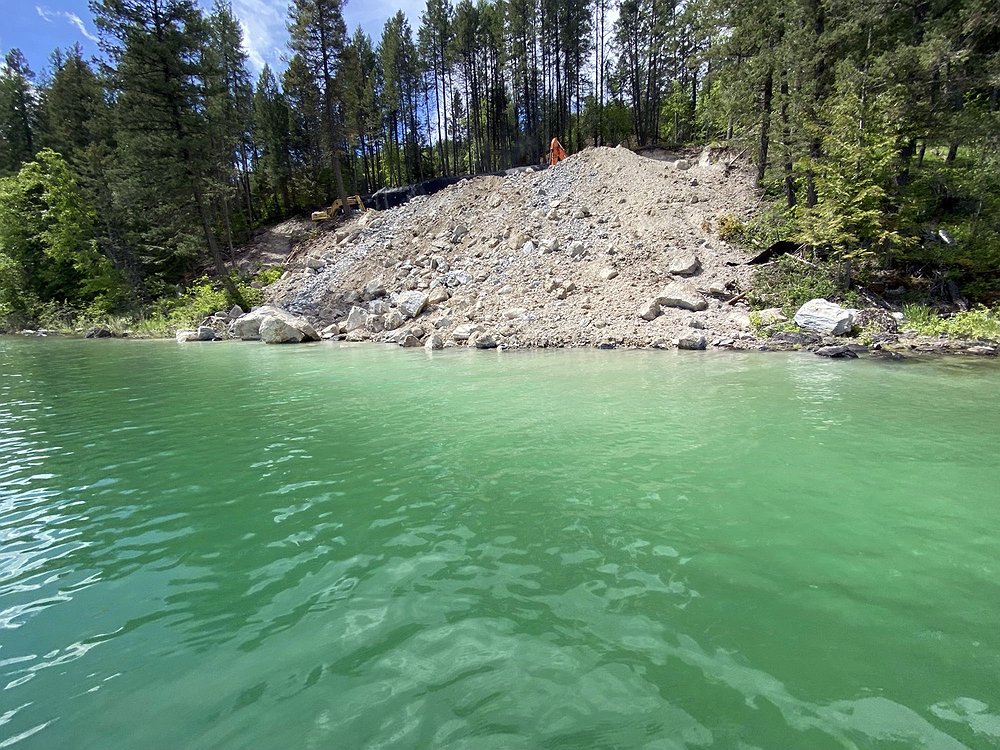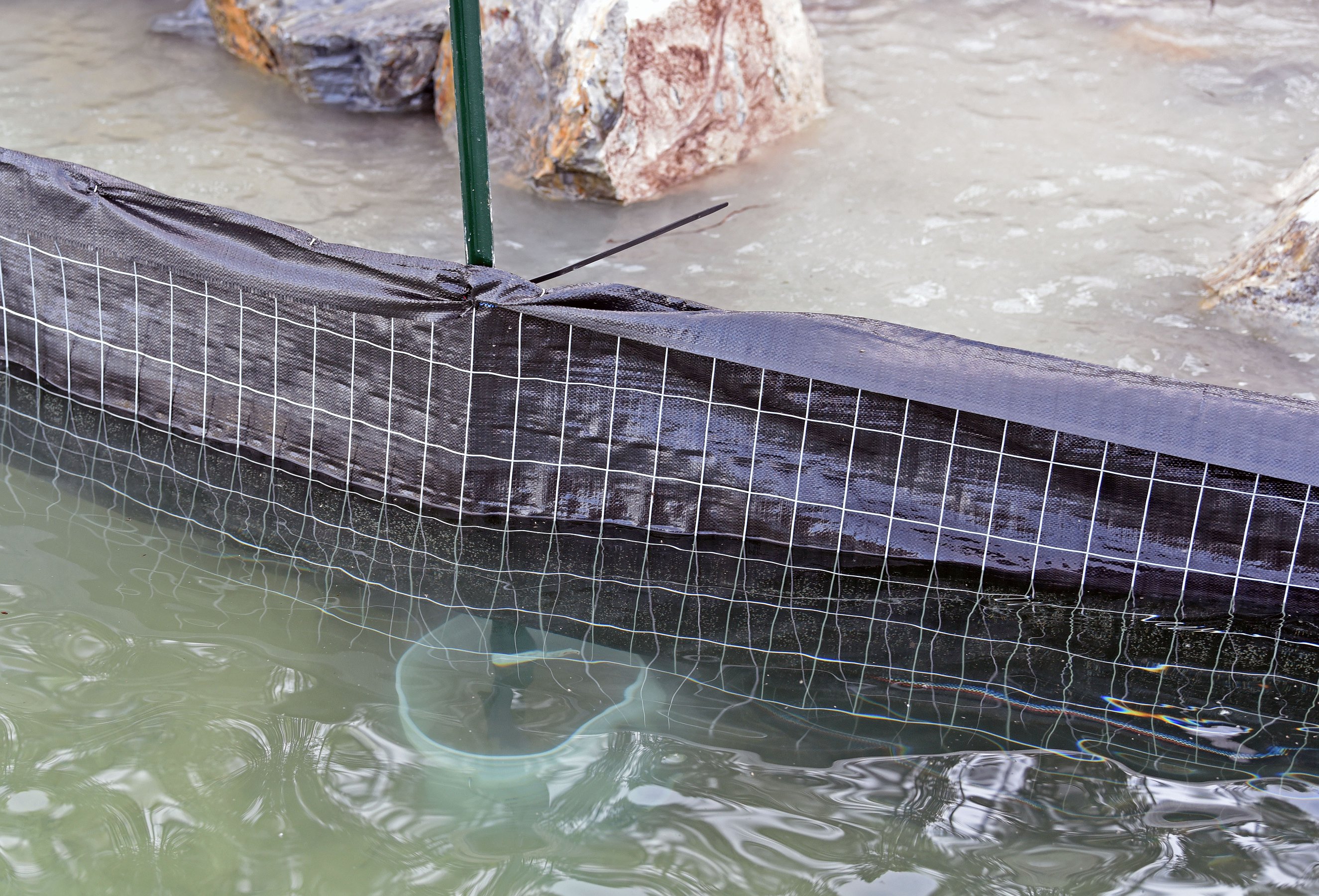Construction causes rockslide on Whitefish Lakeshore
Construction crews using explosives to blast rock for the foundation of a home last month led to a rockslide of debris into Whitefish Lake in what some have described as an "atrocious violation" of lakeshore protection regulations.
The property near the base of Lion Mountain and Beaver Bay on the west side of Whitefish Lake is owned by Charles and Kelly Paquelet of Milwaukee, Wisconsin. The contractors are Whitefish-based High Country Builders. According to the builders, the blasting was done by professionals hired by DLB Inc., of Libby.
The Whitefish Lake Institute field crew observed the aftermath during routine monitoring on May 29.
“Within minutes I emailed both Flathead County and the city of Whitefish of the violation," said Mike Koopal, executive director for the institute. "Within 30 minutes, both entities responded and since the property is in the county, I was able to coordinate transport of the county code enforcement officer on our research boat to the site that afternoon."
Flathead County responded by issuing a partial stop work order within the lakeshore protection zone. County officials also required the contractor to install a silt fence in the lake.
Koopal said the county's proposed mitigation failed to address the environmental issue and "sends the wrong message."
“This is the most egregious lakeshore violation that I’ve witnessed in my 20 years as director of the Whitefish Lake Institute," Koopal said. "The damage has been done. Our focus at this point needs to prioritize the mitigation and remediation of the site to reduce more deleterious effects to the lake."
THE JURISDICTION of Whitefish Lake is complex. Both Flathead County and the city of Whitefish administer lakeshore regulations depending on where a property is located.
For this case, the land is under county jurisdiction, while the city and its Lakeshore Protection Committee cover the surface of the lake. The lakebed is administered by the Montana Department of Natural Resources and Conservation, and the Montana Department of Environmental Quality is responsible for water quality. Montana Fish, Wildlife and Parks manages species and enforcement.
Further complicating enforcement is the fact that Flathead County does not have a building department, leading to little oversight until a dwelling is erected.
Jared Schroeder, code compliance technician for Flathead County Planning and Zoning, said the current priority is developing an abatement plan.
“They [the builders] told me they didn’t mean to do this, but it doesn’t matter right now," Schroeder said. "We need to work toward a resolution.
“The question that matters at the moment is how we are going to clean it up and how to move forward from here.”
According to Schroeder, the builders were prompt and agreeable in putting up a silt fence in the water to prevent further erosion and degradation of water quality.
Schroeder also clarified that the building is outside of the lake and lakeside protection zone.
In Flathead County, the lake and lakeshore protection zone is defined as “the land area which is within 20 horizontal feet of the perimeter of the lake and adjacent wetlands when the lake is at the mean annual high-water elevation.”
The median high water for Whitefish Lake is 3,000.63 feet, and the main construction footprint is more than 20 horizontal feet from that median high water.
Furthermore, without a building department, Flathead County “cannot regulate the construction of the structure outside of the lake and lakeshore protection zone,” Schroeder said.
Schroeder said the building’s footprint is also permitted under SAG-10 zoning.
SAG-10 is defined by Flathead County as “a district to provide and preserve agricultural functions and to provide a buffer between urban and unlimited agricultural uses, encouraging separation of such uses in areas where potential conflict of uses will be minimized, and to provide areas of estate-type residential development.”
However, because debris traveled into the lakeshore protection zone and Whitefish Lake after the blasting, there is a contested violation.
As of June 5, construction has ceased until a cleanup plan is finalized by all involved parties. Moving forward, permits may be required from the Department of Environmental Quality, the Department of Natural Resources and Conservation, and the Army Corps of Engineers.
In an email correspondence sent to Koopal on May 30, Whitefish Mayor John Muhlfeld recommended that the contractor retain professional services from a licensed stormwater pollution prevention plan specialist.
Schroeder said an abatement plan could take a week to finalize.
“I’m checking in regularly," he said. The quicker the better."
According to Koopal, the county hasn’t followed all of his recommendations.
“The purpose of a silt fence is to prevent soil on disturbed land from reaching water,” Koopal said.
This is because “the slope is unstable, and you have boulders the size of cars precipitously situated ready to roll downhill ... all we need is a thunderstorm to further destabilize the slope where material will crash through the silt fence.
“I had recommended a sediment/turbidity curtain be immediately placed to contain sediment delivery to the lake which is a proven technology in a lake environment. At first, the county didn’t follow my recommendation,” Koopal said.
By June 5, however, “The county realized the silt fence was not efficient. The contractor then ordered a turbidity curtain,” Koopal said.
Koopal believes that the Flathead County lakeshore regulations do allow the county to take a more aggressive stance on these issues.
The regulations state that county officials have the authority to take "appropriate action or proceedings to prevent such unlawful erection, maintenance, or use, to restrain, correct, or abate such violation, to prevent the occupancy of such building, structure or land, or to prevent an illegal act, conduct, business, or use in or about such building, structure or land."
Beyond this, the regulations allow for fines up to $500 and/or jail time.
Whitefish resident Jim Stack, who served on the Whitefish Lake and Lakeshore Protection Committee for over 20 years, said the committee would resort to fines regularly.
“During my tenure on the lakeshore committee, we saw this a surprising number of times – particularly with high net worth property owners – where a repeat violation would occur in order to achieve a finished objective, like removing trees or pushing fill into the lake, while knowing that the worst that could happen is a fine and (partial) restoration to a violation that couldn’t fully be restored,” Stack said.
“In the end, the property owner simply paid a financial price for what they wanted – and which wasn’t allowed by lakeshore regulations,” Stack said.
THE ERRANT blasting incident isn’t the first violation on the property. The property was first reported to the county in February 2023 after a skier on the frozen lake filed a complaint after noticing missing trees.
According to Schroeder, the same 20-foot regulation of the lakeshore protection zone applied in that case. Following the complaint, High Country Builders applied for a permit after the occurrence.
This, according to Schroeder, is a common practice for many builders.
“Builders often apply for an after-the-fact permit and then pay double the fees,” Schroeder said.
The Paquelets did not respond to a request for comment.
Walt Landi of High Country Builders said the company is taking action to remediate the blasting incident.
“We were hired to build a two-bedroom home with outdoor patio," Landi explained. "We started this past winter and started hammering for the foundation a month ago and hit solid rock. So we decided to blast, and we hired a professional company to do the blasting, who assured us that it was safe for the lake.
“It was just an accident that ended up with materials in the lake ... there’s about six rocks in the lake and we’re only about 8, 10 feet into the lake.”
Landi said the company has a good reputation and has been in business in Whitefish since 1989.
“We’ve never had anything negative in 35 years. It was an accident that was out of our control. We’ve gone over and above everything we’re supposed to do thereafter. And with the amount of material that’s actually in the water, I don’t want this to be blown out of proportion.
“We are 100% committed to restoring the lakefront affected by the blast that went astray.”
Still, Koopal wants to see stronger enforcement by the county.
“If Flathead County isn’t interested in adequately administering the lakeshore protection regulations on Whitefish Lake, they should consider an inter-local agreement with the city of Whitefish to do so.
“Let’s face it, the homeownership paradigm around Whitefish Lake and other lakes has changed. Lakeshore violations have simply become a minor line-item cost of doing business for many."
He continued, "The health of our streams, rivers, and lakes is defined by the thousands of smaller actions we all make as a society. Our actions today define how heavy of a footprint we leave on the lake for the next generation."
The Lakeshore Protection Committee’s next meeting is June 12 at 6 p.m. at Whitefish City Hall. This incident and regulation enforcement are not on the agenda, but there is an opportunity to submit public comments for items not on the agenda.








